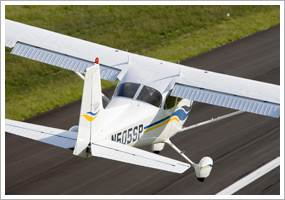Custom content for the Sept. 2, 2011, issue of 'AOPA ePilot' newsletter
| The following stories from the Sept. 2, 2011, edition of AOPA ePilot were provided to AOPA members who expressed an interest in the particular subject areas. Any AOPA member can receive information tailored to their areas of interest by updating their preferences online |
training tipsAccess is everything Abeam the numbers, you check the traffic and observe that the other aircraft is still airborne as it floats past the lone taxiway to the ramp, usually easily “makeable” after a normal final approach. No problem. You also know from personal experience that if you miss, a short back-taxi is all it takes to get clear promptly. The other aircraft, unfortunately, has missed badly—we all have our off days—and now you wonder just how all this is going to work out. You suddenly realize that a go-around has become a real possibility (for which you may not have prepared mentally). The other pilot is apologetic and promising to hurry. Suddenly everyone is a little bit stressed! The lesson? Complacency in one cockpit combined with a surprise dished out from the other can eat up a safety margin that is usually adequate. Don’t forget that limited taxiway access isn’t just a problem for a landing aircraft. That logistical challenge can prolong a departure, too. If a flight is taking the active runway as you are flying into the area, give it plenty of time to get rolling—and stay ready for the unexpected, such as an aborted takeoff. Two related tips: Before flying to a new destination airport such as this one with limited access and egress, review the airport layout. Ask yourself how you would clear the runway under various scenarios. Check airport remarks or comments. Surface irregularities may make it impossible to see another aircraft on the ground near the runway’s far end. If things get hectic, don’t express frustration; the other guy probably feels as bad about the situation as you do. (Your indignation could also become distracting.) You may even find out from an observer or the other pilot that there was a good reason for the long landing—an outbound aircraft blocking the way onto the ramp, perhaps—making you glad that you didn’t pass judgment without knowing all the facts!training products‘Flying the Cessna Skycatcher’ from King SchoolsIs a Cessna Skycatcher in your aviation future? If so, King Schools’ new DVD course, Flying the Cessna Skycatcher, may be just the ticket for getting you up to speed. The course is designed for pilots making the transition to the Skycatcher, and includes in-flight video and a tutorial on the airplane’s Garmin G300 avionics. It sells for $149. Order online or call 800/854-1001.
Note: Products listed have not been evaluated by ePilot editors unless otherwise noted. AOPA assumes no responsibility for products or services listed or for claims or actions by manufacturers or vendors. final exam
Question: What are the right-of-way rules for aircraft operating on water?
Answer: In general, federal aviation regulation 91.115 states that individuals operating aircraft on the water should, if possible, keep clear of other vessels and avoid getting in their way and/or impeding their navigation. They should also yield the right of way to any vessel or aircraft if instructed to do so under this regulation. Some circumstances are addressed specifically by the regulation. If on a crossing course with another aircraft or vessel, the entity on the right has the right of way. Approaching head on, alter your course to the right. If a vessel or aircraft is being overtaken, the vessel or aircraft being overtaken has the right-of-way and the one overtaking should change course to remain well clear. If a collision threat exists, consider the limitations of the vessel or aircraft involved, and choose appropriate actions. For right-of-way rules while on the ground or in the air, read “Who has the right of way?”
Got a question for our technical services staff? E-mail [email protected] or call the Pilot Information Center, 800/872-2672. Don’t forget the online archive of “Final Exam” questions and answers, searchable by keyword or topic. |
 The traffic you are following in the pattern is in sight. Separation looks good; by the time you turn base, the other aircraft should be down and off. The other pilot knows your position. The system for coordinating operations at a
The traffic you are following in the pattern is in sight. Separation looks good; by the time you turn base, the other aircraft should be down and off. The other pilot knows your position. The system for coordinating operations at a 

